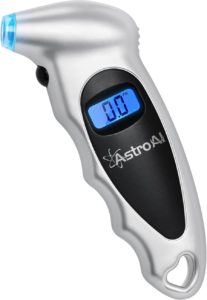The 2015-2024 Jaguar XF does not have a tire pressure reset button. This makes it essential to learn how to reset your tire pressure warning light. All you have to do is set your tires to the exact pressures recommended on the sticker in your door jamb.
Steps to Reset Jaguar XF TPMS
Step 1: Check Your Tire Pressure
Using the steering wheel controls.
Select MENU
Select VEHICLE INFORMATION
Select TIRE PRESSURES
The recommended tire pressure values are shown next to your current tire pressures in parenthesis.
Step 2: Adjust Your Tire Pressure
Fix or Adjust your tire pressures to the recommended pressures. Do this with a tire inflator at your local gas station or a portable tire inflator. Remember to adjust the tire pressure only when the tires are cold. (This means before driving long distances or after the car has been parked for a few hours)
Trim Model | Tire Size | Inflation PSI FRONT/REAR |
Jaguar XF | 245/40R19 | 43 PSI/48 PSI |
Jaguar XF | 245/45R18 | 43 PSI/48 PSI |
Jaguar XF | 255/35R20 | 43 PSI/48 PSI |
Jaguar XF | SPARE | 60 PSI |
Step 3: Drive Your Jaguar XF
Drive your Jaguar XF for at least 15 minutes to reset the tire pressure monitoring system. The TPMS light on the dashboard will turn off. Remember the tires need to be exactly what is recommended by Jaguar.
Jaguar XF
Your Jaguar XF comes with a TPMS malfunction indicator that lets you know if the system isn’t working properly. The indicator works alongside the low tire pressure warning light. When the tire monitoring system experiences a problem, the warning light will flash for about 75 seconds before staying on continuously. This pattern repeats every time you start your car until the issue is fixed. Basically, if your tire light is flashing and then stays on, your vehicle has lost communication with one or more tire pressure sensors due to a dying or dead sensor. In short, a flashing tire pressure light signals an issue with the TPMS system itself, not an air pressure problem. So, if you have a defective tire pressure sensor, your TPMS will not function properly. This sequence will also occur if you have a wheel on the vehicle without a sensor in it.
Reset Your TPMS in the Following Cases:
After tire pressure has been corrected or adjusted.
After a pressure sensor has been replaced or swapped.
After a tire rotation has been performed.
After tire balances or wheel alignments.
After any tire or wheel has been replaced.
After your vehicle battery dies, been drained, or jumped.
After the TPMS light turns on.
How Jaguar XF TPMS Works
The Jaguar XF TPMS is designed to constantly monitor the air pressure in all four tires of the vehicle.
The system uses four tire pressure sensors, one for each wheel, which are located on the inside of the valve stem. These sensors continuously measure the tire pressure and send data wirelessly to the car’s computer.
The TPMS in the Jaguar XF is a direct system, meaning that each tire has its own sensor, as opposed to an indirect system that uses the vehicle’s ABS (Anti-lock Braking System) to measure pressure.
The Jaguar XF TPMS alerts the driver if the tire pressure drops below a certain level. The system uses a warning light on the dashboard to signal that one or more tires have low pressure.
When the TPMS detects low tire pressure, it will also display a message on the infotainment screen that provides information about which tire is affected and how much the pressure has dropped.
What Causes the TPMS Light to Turn On?
Low tire pressure: The most common cause, when one or more tires are underinflated, falling below the manufacturer’s recommended pressure level.
Overinflated tires: If a tire is inflated beyond the recommended pressure, the can sometimes cause the tire light to turn on.
Seasonal temperature changes: When the temperature drops, tire pressure decreases in tires. This is extremely common!
Sensor malfunction: A faulty tire pressure sensor may provide inaccurate readings, triggering the warning light.
TPMS battery issues: A dying or dead battery in a tire pressure sensor will cause the system to activate a TPMS malfunction light explained above.
TPMS malfunction: An issue with the TPMS receiver module will also cause the malfunction indicator.
Air Temperature Affects on Tire Pressure
The chart above illustrates the relationship between air temperature and tire pressure changes in both Fahrenheit and Celsius, as well as PSI and kPa units. It proves that as the temperature decreases, tire pressure drops accordingly, while the opposite occurs when the temperature increases. The baseline temperature for checking tire pressure is considered to be around 62°F (16.7°C), where no real tire pressure changes will occur. Basically, for every 10 degree drop in air temperature, about 1 Psi tire pressure will decrease.
The Benefits of TPMS in Jaguar XF:
Early warning system: The TPMS alerts you when the tire pressure drops too low, so you can take action before it becomes a bigger problem.
Improved safety: Properly inflated tires are crucial for safety, and the TPMS helps ensure that all four tires are at the right pressure level, reducing the risk of accidents or tire blowouts.
Better fuel efficiency: When your tires are properly inflated, you can get better gas mileage and save money on fuel costs.
Longer tire life: Overinflated or underinflated tires will wear out faster, but the TPMS helps you keep them at the right pressure, so they’ll last longer.
Reduced maintenance costs: By catching tire pressure problems early, the TPMS can help prevent costly repairs or replacements down the line.
Improved handling: Properly inflated tires provide better handling and stability, especially in wet driving conditions. The TPM helps make sure your tires are at the right pressure for optimal performance.
Easy to use: The TPMS is designed to be user-friendly, with clear warning lights and messages to let you know when there’s a problem.
Comprehensive monitoring: The TPMS continuously monitors all four tires, giving you peace of mind that any issues will be quickly detected.
Enhanced driving experience: By giving you real-time information about your tire pressure, the TPMS can help you feel more in control and confident on the road.
Please note that this blog post contains Amazon affiliate links. This means that if you make a purchase through one of these links, we at TPMSRESET.com may earn a small commission at no extra cost to you. We only recommend products that they personally use and believe in. Thank you for supporting this blog.





